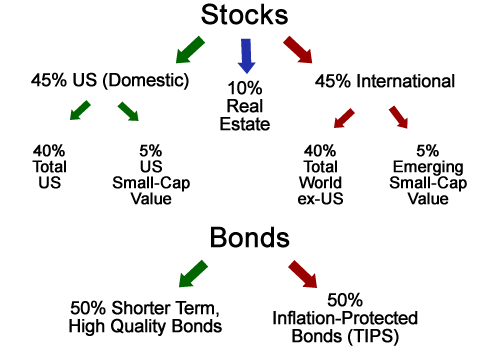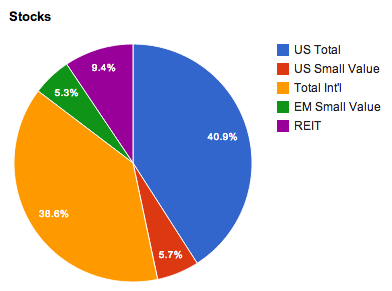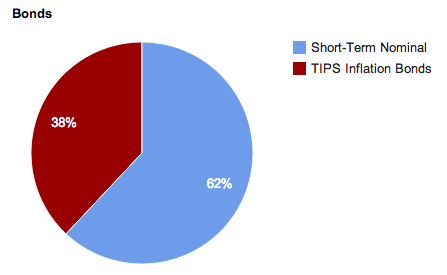Here’s a mid-2013 update of our retirement portfolio, including employer 401(k) plans, self-employed retirement plans, Traditional and Roth IRAs, and taxable brokerage holdings. Cash reserves (emergency fund), college savings accounts, experimental portfolios, and day-to-day cash balances are excluded. The purpose of this portfolio is to eventually create income and enable financial freedom.
Target Asset Allocation
Since my last update, I made a minor change to our target asset allocation by removing Emerging Markets as a separate added weighting as it now includes some huge companies and comprises nearly 20% of the Total World ex-US (Total International) asset class.

I replaced it with Emerging Markets Small Value, focusing on the smaller, less-popular, less-trendy companies in those emerging countries. I think this fits better as the small 5% slices were always meant to spice things up a bit with a little extra risk in exchange for the possibility of a little extra return.
In general, I pick asset classes that are likely to provide a long-term return above inflation, as well as offer some historical tendencies to be less correlated to each other. I don’t hold commodities futures or gold because I am not confident in them enough to know that I will hold them through an extended period of underperformance (and if you don’t do that, there’s no point). Our current ratio is about 70% stocks and 30% bonds. Our investment strategy remains buy, hold, and rebalance. With low expense ratios and low turnover, we minimize our costs in terms of paying fees, commissions, and taxes.
Actual Holdings
Here is our actual asset allocation:


Stock Holdings (Ticker Symbol)
Vanguard Total Stock Market Fund (VTI, VTSMX, VTSAX)
Vanguard Total International Stock Market Fund (VXUS, VGTSX, VTIAX)
WisdomTree SmallCap Dividend ETF (DES)
WisdomTree Emerging Markets SmallCap Dividend ETF (DGS)
Vanguard REIT Index Fund (VNQ, VGSIX, VGSLX)
Bond Holdings
Vanguard Limited-Term Tax-Exempt Fund (VMLTX, VMLUX)
Vanguard High-Yield Tax-Exempt Fund (VWAHX, VWALX)
PIMCO Total Return Institutional* (PTTRX)
Stable Value Fund* (2.6% yield, net of fees)
iShares Barclays TIPS Bond ETF (TIP)
Individual TIPS securities
US Savings Bonds
For my US small-cap value allocation, I recently sold the Vanguard Small-Cap Value ETF (VBR) and replaced it with the WisdomTree SmallCap Dividend ETF (DES). The new ETF has holdings that are on average smaller and deeper value, but at a slightly higher expense ratio. I also added the WisdomTree Emerging Markets SmallCap Dividend ETF (DGS); I love that I’ve never heard of the companies that make up the Top 10 holdings of this fund. I think these two new ETFs do a good job of reaching into areas not well-covered by the huge, broad index funds (I couldn’t find any overlap between VXUS and DGS at all). Each of them only makes up less than 4% of the total portfolio, so again they just add a little spice to the mix.
With our ~30% allocation to bond holdings, I admit to doing some yield-chasing while still maintaining a high credit quality and relatively short duration. I still don’t like US Treasuries, the yields seem to be so low due to demand from countries and institutions that need safety and liquidity for their billions and trillions. In contrast, smaller individual investors can take advantage of higher effective yields from high-quality municipals, small stable value funds, and US savings bonds. I still like the inflation-protection of TIPS, although not nearly as much as in the past.
(Market commentary: Bond rates have been rising recently, but isn’t that a good thing? I’m happy to have my bonds go down a bit if that is result from my stocks are doing well. My portfolio is doing great as whole. I’m keeping my bonds because they still lower my overall risk profile if stocks go back down. Rising rates mean I’ll earn more interest on the money I invest in the future.)
With the volatility of the markets both up and down, I’m starting to think that for the purposes of early retirement I should only depend the income that comes off of this balanced portfolio (more stable) and simply hoping the principal keeps up with inflation over the long-haul. I don’t want to be one of those retirees that check the stock quotes every day. The overall dividend yield of my stocks between 2-3% and the overall bond yield is a little over 2%. Gotta spend some more time looking into this.
 The Best Credit Card Bonus Offers – 2025
The Best Credit Card Bonus Offers – 2025 Big List of Free Stocks from Brokerage Apps
Big List of Free Stocks from Brokerage Apps Best Interest Rates on Cash - 2025
Best Interest Rates on Cash - 2025 Free Credit Scores x 3 + Free Credit Monitoring
Free Credit Scores x 3 + Free Credit Monitoring Best No Fee 0% APR Balance Transfer Offers
Best No Fee 0% APR Balance Transfer Offers Little-Known Cellular Data Plans That Can Save Big Money
Little-Known Cellular Data Plans That Can Save Big Money How To Haggle Your Cable or Direct TV Bill
How To Haggle Your Cable or Direct TV Bill Big List of Free Consumer Data Reports (Credit, Rent, Work)
Big List of Free Consumer Data Reports (Credit, Rent, Work)
I subscribe to a newsletter of a statistical analysis tool called Quantext. They recently analyzed a series of bond portofolios attempting to demonstrate that it was possible to get better yield than US treasuries with lower volatility and less interest rate risk. Might be worth a read.
http://advisorperspectives.com/newsletters13/A_Better_Alternative_to_Cap-Weighted_Bond_Indices.php
I could do it myself, but I’m lazy today :), but have you run this portfolio through the Morningstar Xray tool? That tool breaks down the holdings into the 9 style boxes (l/m/s val/bluend/growth). It makes it easier to compare this with other portfolios that dont use the exact same funds as well as show the real breakdown based on holdings vs name. Each fund can be slightly biased to a corner more than another. Non-index funds can also shift more over time.
What do you think at EEMV at .25 expense ratio vs DGS at .63?
@Thad – Yes I’ve done the M* boxes. I’ve also compared VBR vs. DES and EEM vs. DGS.
@Dan23 – EEMV tracks the MSCI Emerging Markets Minimum Volatility Index, which isn’t really a small or value index. The average market cap of its 207 holdings is $19B making it a large cap slightly growth ETF. DGS has average market cap of $1.4B with over 500 holdings, significantly smaller companies.
Do you buy DGS in taxable (pay taxes, maybe non-qualified) or tax-deferred (lose foreign tax credit)? I could never find the ideal location for such funds/ETFs.
I chose to buy DGS in taxable as I have no room in my tax-deferred accounts which are filled with things like TIPS which are even less tax-efficient. Also within the next decade or so, I plan to start spending the dividend income in “retirement”.
Jonathan, LOVE your blog. Quick question: What program do you use to track your asset allocation for re-balancing purposes? I have had trouble finding one that is basic and easy to use. Thank you in advance for your help and for your blog!
I notice that your graphic show 62% short term bonds, but your holdings show what Morningstar catagorizes as intermediate term bond funds:
Vanguard High-Yield Tax-Exempt Fund
and
PIMCO Total Return Institutional
Do you consider the bonds in these funds as “short duration”?
Is there more risk in your bond portfolio than you are recognizing?
Bill Gross’ track record is unquestionable but perhaps investments in this area should be categorized as intermediate term bond holdings. I’m holding that too, but I represent it as an intermediate term bond holding. Granted the duration of bonds in this fund do average less than 5 years, so it is on the short side of intermediate, so to speak.
I’ve been using Vanguard Short-Term Bond Idx for my short term investments. It’s return sucks, but it has low expenses and is truly a short term bond fund. I’d like to think as rates turn, this fund will take less of a beating, and show upside sooner. Your thoughts?
@Tyler W – Thanks! I just use a Google Docs spreadsheet myself, but try this post out for some more detailed options:
https://www.mymoneyblog.com/access-morningstar-x-ray-portfolio-management-tools-for-free.html
@Alan – I agree that PTTRX and VWALX are intermediate-term bonds. I do have them mixed in with the other bond funds but still consider the overall average duration to be around 2-3 years and thus just keep it as “shorter” duration. Stable value funds don’t drop in principal when rates rise (at least that’s the idea). I’m okay with the higher yield trading off with higher interest rate risk at this end of the spectrum. If rates rise, I’ll get paid those higher rates soon enough.
I don’t see anything wrong with the short-term bond index. I’d probably pick the short-term corporate bond index instead, but that’s just a personal preference.
Interesting blog Jonathan. I agree with your switch to emerging market small value. The ‘less-trendy companies’ as you put it are the way to go. Good luck.
Jonathan, I’m growing to appreciate your Financial Freedom KPIs in the upper right corner and was wondering if you post the growth history anywhere?
It seems like your % of Expenses Replaced is on a wonderful pace. Also curious if that metric is adjusted for your changing expense rate at some sort of regular interval – maybe yearly perhaps? Based on my experience our family expenses have risen significantly as the kids have gotten bigger. I’m curious with your family arrangement of part-time work how the expenses adjust over the next couple years.
@2million – Thanks, looks like you guys are also doing quite well. No, I don’t really post the growth history, it has gone up and down with the stock market as well as with additional contributions. It’s more of a personal reminder. The expenses denominator is updated now and then but is mostly a conservative estimate based on current expenses plus a certain cushion for expected self-paid health insurance and additional child-related expenses like preschool and secondary activities. Now that we’re getting to close to the number, I’ll have to see if I’m really ready to take the jump based on our projections…
When will you be updating this again? I’m just curious to see what funds have changed, been added, removed, etc. Thanks! Love the website.